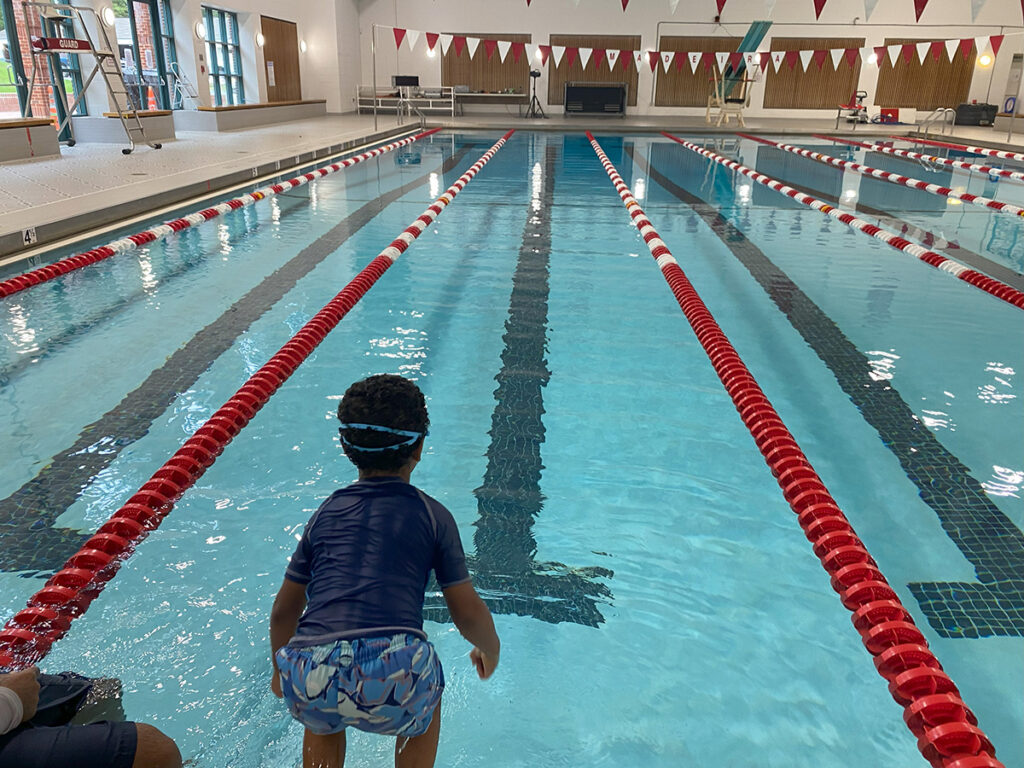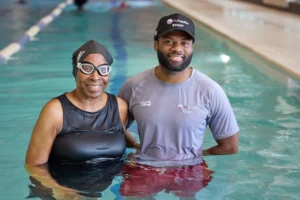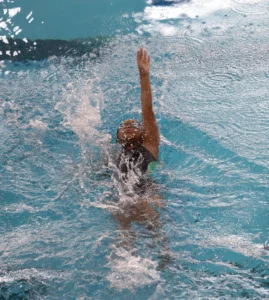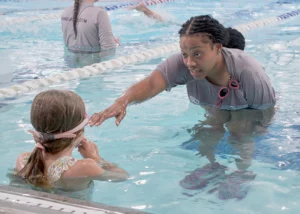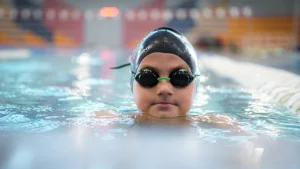Discover How Swim Etiquette Makes It More Enjoyable for Everyone
Swimming is a great, accessible activity for most people that offers countless benefits. However, we understand that stepping into the pool area, especially if it’s your first time or if you haven’t been in a while, can be a bit intimidating.
We want everyone— from parents bringing in their little ones to adults rediscovering their love of water— to feel comfortable and confident at lessons and in the pool environment.
You’ve probably noticed that there seem to be certain unspoken pool rules. Maybe you’ve wondered if you’re following the rules or unintentionally breaking some unwritten code. We get it, and we’re here to help!
We’re giving you insider tips to help you navigate the pool like a pro.
General Swimming Pool Etiquette
Before getting in the pool:
- Shower before entering the pool: This isn’t a suggestion. This is a rule at most pools. Showering removes sweat, oils, and other contaminants, helping keep the pool clean.
- Wear appropriate swimwear: Don’t wear regular street clothes into the pool. They can become heavy when wet, making them dangerous, and their fibers break down and clog mechanical equipment.
- Use the restroom: Take a bathroom break before entering the pool and take frequent breaks to relieve yourself.
- No running: The pool deck can become slippery, so walk carefully to avoid accidents.
In the pool:
- Be aware of your surroundings: Always be mindful of other swimmers, especially small children and less confident swimmers.
- Don’t dip your foot into the pool with shoes on: While it’s fine to wear shoes before getting into and out of the pool, take them off to avoid contaminating the water.
Respect pool equipment: Use kickboards, pull buoys, and other equipment as intended and return them afterward.
Health and Safety at the Pool
Don’t swim if you’re ill: This is especially important if you have diarrhea, a fever, or other symptoms.
Stay out of the pool if you have an open wound or rash: Wait until you’re fully healed to jump in the pool again.
Inform your instructor or lifeguards (if you’re swimming alone) of medical conditions: If you have a condition that may require assistance, let someone know.
Use proper swim diapers on infants and young children: Regular diapers can become ineffective at containing contaminants once submerged and this is why they’re prohibited.
Take frequent restroom breaks: Encourage children to use the restroom regularly to prevent accidents.
Apply sunscreen wisely: Use water-resistant or zinc oxide sunscreen and allow it to dry before taking a shower and entering the pool to prevent water contamination.
Listen to lifeguards and instructors: If they give you instructions, it’s because they are trying to keep you or other swimmers safe.
Swimming Pool Etiquette at Lessons
Before the Lesson:
- Arrive early: This allows time to change, use the restroom, and get familiar with your surroundings.
- Come prepared: Bring all necessary equipment like goggles, swim caps, towels, and water.
- Wait for your instructor: Don’t enter the pool until your instructor indicates it’s time to begin class.
Parent Etiquette:
- Observe from a distance: Parents can distract little ones learning new skills, so watch from afar to reduce their wandering attention.
- Keep siblings in check: If you bring other children to the lesson, be sure they are not disrupting classes or other swimmers or endangering themselves or others near the pool.
Communicate with instructors appropriately: If you’d like to discuss your child’s progress, speak after class or schedule a time outside of class.
Lap Swimming Etiquette
Choosing your lane:
- Select a lane that matches your speed: Most pools designate slow, medium, and fast lanes. Choose the one that fits your pace to avoid frustrating other swimmers.
- Enter the lane carefully: Before jumping in, ensure you’re not disrupting ongoing swimmers or training.
Sharing the lane:
- Circle swim when there are three or more swimmers: Stay to the right of the lane, swimming counterclockwise.
- Allow faster swimmers to pass: If someone taps your foot, move to the side at the next turn and let them pass.
- Don’t push off right in front of another swimmer: Give adequate space when starting your lap.
Resting and Turning:
- Rest in the corners: When you need to take a break, stay close to the wall and out of other swimmers’ way.
Turn in the center of the lane: This also allows space for others to turn.
Each WeAquatics location may have a different atmosphere, but they all follow the same general swimming pool etiquette.
Remember, we are sharing this space with everyone from tiny tots taking essential water survival classes in Infant Swimming Resource™ classes to grandparents perfecting their backstroke in Learn-to-Swim lessons.
By following this general pool etiquette, you’re not just being considerate— you’re becoming part of our awesome WeAquatics community. Think of it as good aquatic citizenship! You’re respecting the shared facilities and our instructors and showing good sportsmanship to your fellow swimmers.
We’re all in this pool together— literally! So let’s make this a positive experience for everyone!
Ready to show off your newfound pool etiquette? Download our Swimming Etiquette tips and sign up for WeAquatics lessons!

